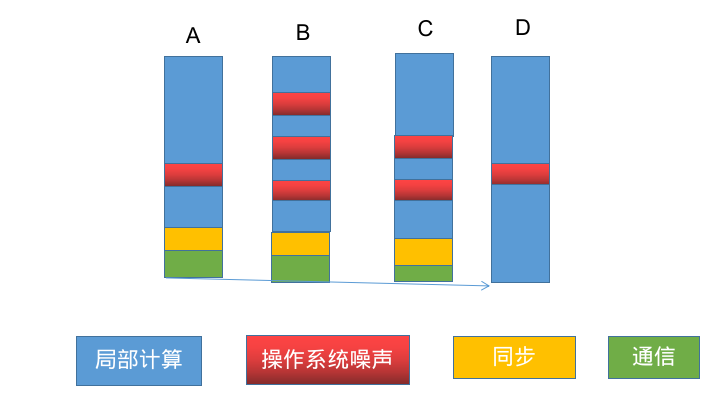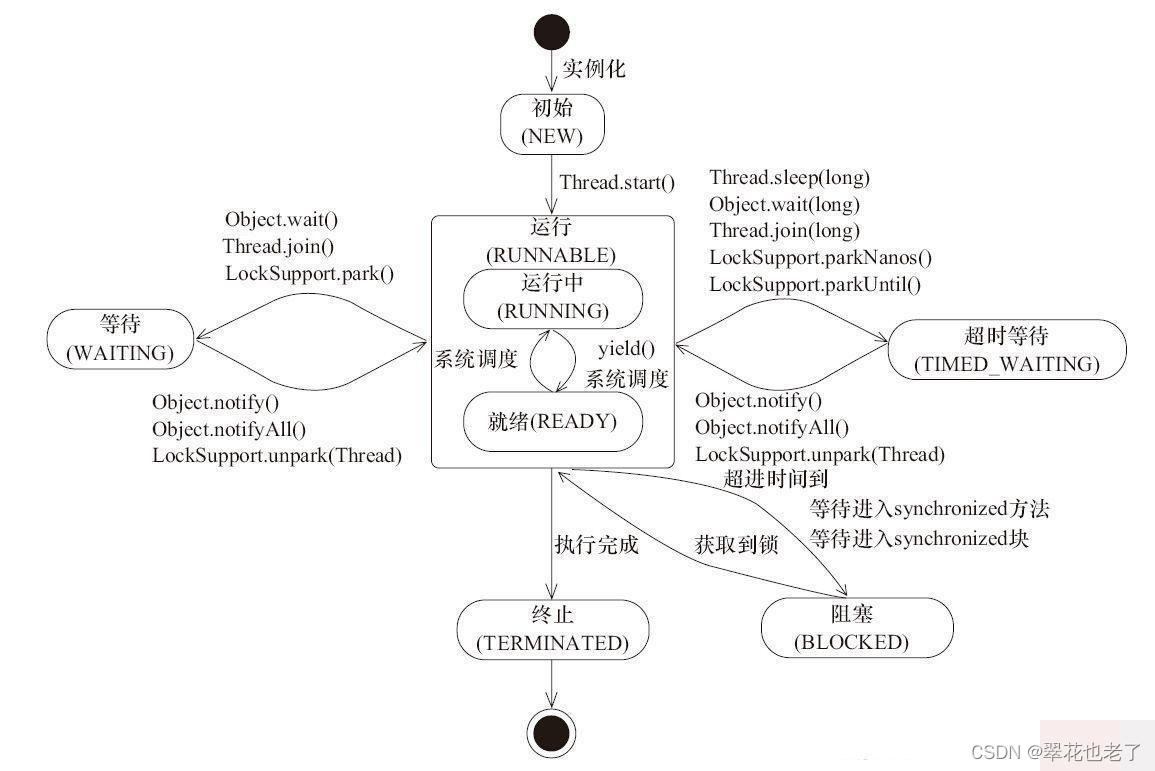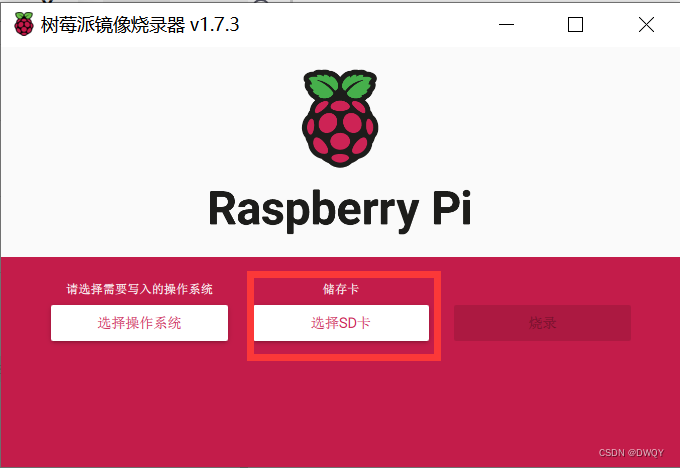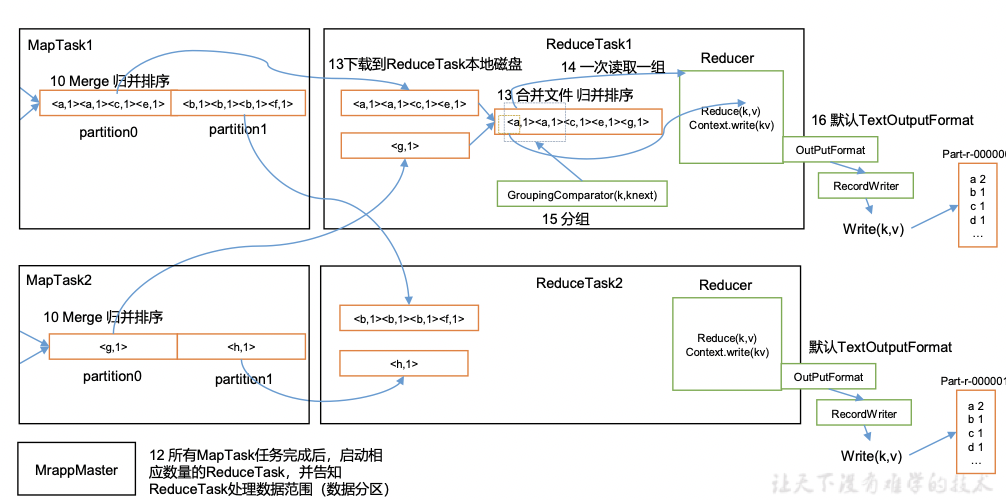首先先附上mybatis的官方文本链接mybatis – MyBatis 3 | 简介
一、Mybatis介绍
MyBatis 是一款优秀的持久层框架,它支持自定义 SQL、存储过程以及高级映射。MyBatis 免除了几乎所有的 JDBC 代码以及设置参数和获取结果集的工作。MyBatis 可以通过简单的 XML 或注解来配置和映射原始类型、接口和 Java POJO(Plain Old Java Objects,普通老式 Java 对象)为数据库中的记录。
简单来说,mybatis极大的方便我们对数据库的操作,在没有学mybatis之前,我们操作数据库的步骤十分繁琐,且编写sql语句复用性不高,而mybatis可以极大的方便我们操作数据库和编写sql,同时最重要的是体现了开发中的低耦合的特点,我们现在只需要进行对xml文件的修改就可以操作数据库和进行编写sql!!!
二、第一个Mybatis程序
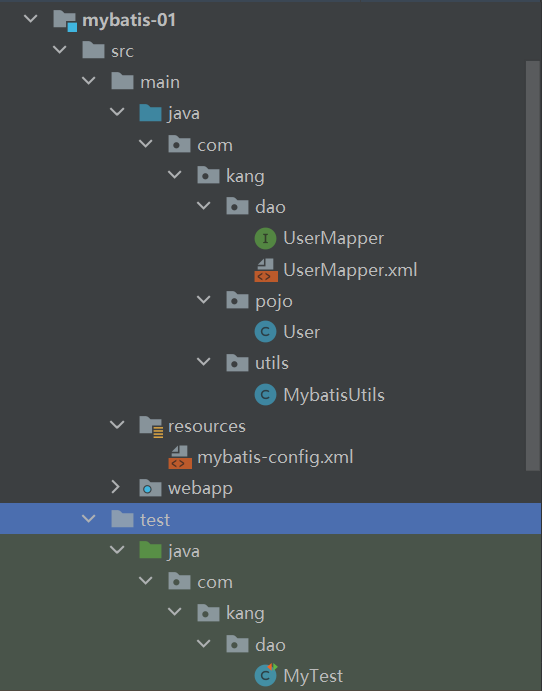
2.1、 环境搭建
搭建数据库
CREATE DATABASE `mybatis`;
USE `mybatis`;
DROP TABLE IF EXISTS `user`;
CREATE TABLE `user` (
`id` int(20) NOT NULL,
`name` varchar(30) DEFAULT NULL,
`pwd` varchar(30) DEFAULT NULL,
PRIMARY KEY (`id`)
) ENGINE=InnoDB DEFAULT CHARSET=utf8;
insert into `user`(`id`,`name`,`pwd`) values (1,'狂神','123456'),(2,'张三','abcdef'),(3,'李四','987654');导入mybatis相关jar包
<dependency>
<groupId>org.mybatis</groupId>
<artifactId>mybatis</artifactId>
<version>3.5.2</version>
</dependency>
<dependency>
<groupId>mysql</groupId>
<artifactId>mysql-connector-java</artifactId>
<version>5.1.47</version>
</dependency>编写mybatis-config核心配置文件
<?xml version="1.0" encoding="UTF-8" ?>
<!DOCTYPE configuration
PUBLIC "-//mybatis.org//DTD Config 3.0//EN"
"http://mybatis.org/dtd/mybatis-3-config.dtd">
<configuration>
<environments default="development">
<environment id="development">
<transactionManager type="JDBC"/>
<dataSource type="POOLED">
<property name="driver" value="com.mysql.cj.jdbc.Driver"/>
<property name="url" value="jdbc:mysql://localhost:3306/mybatis?useSSL=true&useUnicode=true&characterEncoding=utf8"/>
<property name="username" value="root"/>
<property name="password" value="123456"/>
</dataSource>
</environment>
</environments>
<mappers>
<mapper resource="com/kang/dao/UserMapper.xml"/>
</mappers>
</configuration>
编写Mybatis工具类
为什么要这样写,这个详细见mybatis官方文档,地址在文章开头
import org.apache.ibatis.io.Resources;
import org.apache.ibatis.session.SqlSession;
import org.apache.ibatis.session.SqlSessionFactory;
import org.apache.ibatis.session.SqlSessionFactoryBuilder;
import java.io.IOException;
import java.io.InputStream;
public class MybatisUtils {
private static SqlSessionFactory sqlSessionFactory;
static {
try {
String resource = "mybatis-config.xml";
InputStream inputStream = Resources.getResourceAsStream(resource);
sqlSessionFactory = new SqlSessionFactoryBuilder().build(inputStream);
} catch (IOException e) {
e.printStackTrace();
}
}
//获取SqlSession连接
public static SqlSession getSession(){
return sqlSessionFactory.openSession();
}
}创建pojo
这个在后续会引入一个插件lombok,可以简化pojo
package com.kang.pojo;
public class User {
private int id;
private String name;
private String pwd;
@Override
public String toString() {
return "User{" +
"id=" + id +
", name='" + name + '\'' +
", pwd='" + pwd + '\'' +
'}';
}
public int getId() {
return id;
}
public void setId(int id) {
this.id = id;
}
public String getName() {
return name;
}
public void setName(String name) {
this.name = name;
}
public String getPwd() {
return pwd;
}
public void setPwd(String pwd) {
this.pwd = pwd;
}
public User(int id, String name, String pwd) {
this.id = id;
this.name = name;
this.pwd = pwd;
}
public User() {
}
}
编写Mapper接口
import com.kang.pojo.User;
import java.util.List;
public interface UserMapper {
List<User> selectUser();
}Mapper配置文件
<?xml version="1.0" encoding="UTF-8" ?>
<!DOCTYPE mapper
PUBLIC "-//mybatis.org//DTD Mapper 3.0//EN"
"http://mybatis.org/dtd/mybatis-3-mapper.dtd">
<mapper namespace="com.kang.dao.UserMapper">
<select id="selectUser" resultType="com.kuang.pojo.User">
select * from user
</select>
</mapper>编写测试类
@Test
public void selectUser() {
//获取sqlSession
SqlSession session = MybatisUtils.getSqlSession();
//获取mapper
UserMapper mapper = session.getMapper(UserMapper.class);
//调用mapper定义的方法
List<User> userList = mapper.selectUser();
for (User user : userList) {
System.out.println(user.toString());
}
session.close();
}2.2、 问题说明
1.Maven静态资源过滤问题
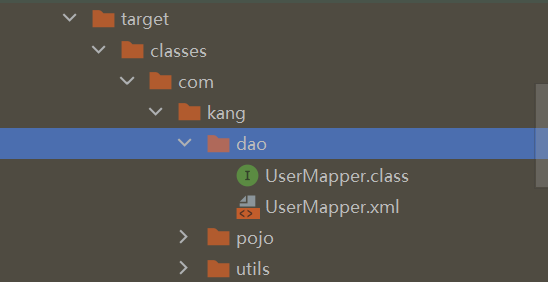
若你dao包下没有xml文件说明存在maven过滤问题,这个我们只需要在pom文件加以下代码就可以解决
<resources>
<resource>
<directory>src/main/java</directory>
<includes>
<include>**/*.properties</include>
<include>**/*.xml</include>
</includes>
<filtering>false</filtering>
</resource>
<resource>
<directory>src/main/resources</directory>
<includes>
<include>**/*.properties</include>
<include>**/*.xml</include>
</includes>
<filtering>false</filtering>
</resource>
</resources>2.3、 编译器问题
这里我所使用的编译工具是idea2020.2 这里可能会存在一个问题,就是每次我们修改我们的Mapper文件后,我们必须手动的clean以前的Mapper,否则我们的修改过后的Mapper无法更新,这里手动的方法如下图
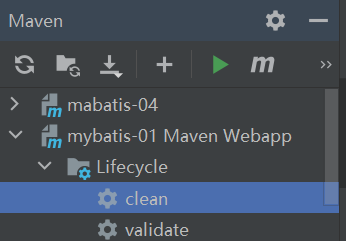
三、CRUD操作
3.1、 重要标签
select标签是mybatis中最常用的标签之一
select语句有很多属性可以详细配置每一条SQL语句
id
命名空间中唯一的标识符
接口中的方法名与映射文件中的SQL语句ID 一一对应
parameterType
传入SQL语句的参数类型 。【万能的Map,可以多尝试使用】
resultType
SQL语句返回值类型。【完整的类名或者别名】
Mapper接口
//根据名称模糊查询
List<User> selectUsersByName(String name);
//根据id查询用户
User getUserById(int id);
//新增一个用户
int addUser(User user);
//根据id修改用户
int updateUser(User user);
//根据id删除用户
int deleteUserById(int id);
//map 查询
User selectUserByNP2(Map<String,Object> map);Mapper.xml
<!--根据id查询用户-->
<select id="getUserById" parameterType="int" resultType="com.kang.pojo.User">
select * from user where id = #{id}
</select>
<!--增加用户-->
<insert id="addUser" parameterType="com.kang.pojo.User">
insert user(id,name,pwd) values (#{id},#{name},#{pwd})
</insert>
<!--修改用户信息-->
<update id="updateUser" parameterType="com.kang.pojo.User">
update user set name = #{name},pwd = #{pwd} where id = #{id}
</update>
<!--删除用户信息 -->
<delete id="deleteUserById" parameterType="int">
delete from user where id = #{id}
</delete>
<!-- map查询-->
<select id="selectUserByNP2" parameterType="map" resultType="com.kang.pojo.User">
select * from user where name = #{username} and pwd = #{password}
</select>
<!--模糊查询-->
<select id="selectUsersByName" parameterType="String" resultType="com.kang.pojo.User">
select * from user where name like #{value}
</select>测试类
@Test
public void selectUserById(){
SqlSession sqlSession = MybatisUtils.getSqlSession();
UserMapper mapper = sqlSession.getMapper(UserMapper.class);
User userById = mapper.getUserById(1);
System.out.println(userById);
}
@Test
public void addUser(){
SqlSession sqlSession = MybatisUtils.getSqlSession();
UserMapper mapper = sqlSession.getMapper(UserMapper.class);
int addUser = mapper.addUser(new User(4, "张婧怡", "121223"));
sqlSession.commit();
System.out.println(addUser);
}
@Test//模糊查询
public void selectUsersByName(){
SqlSession sqlSession = MybatisUtils.getSqlSession();
UserMapper mapper = sqlSession.getMapper(UserMapper.class);
List<User> users = mapper.selectUsersByName("%张%");
for (User user : users) {
System.out.println(user);
}
}
@Test
public void updateUser(){
SqlSession sqlSession = MybatisUtils.getSqlSession();
UserMapper mapper = sqlSession.getMapper(UserMapper.class);
User user = mapper.getUserById(4);
user.setPwd("121212");
user.setName("帅哥");
int i = mapper.updateUser(user);
sqlSession.commit();
System.out.println(i);
}
@Test
public void deleteUserById(){
SqlSession sqlSession = MybatisUtils.getSqlSession();
UserMapper mapper = sqlSession.getMapper(UserMapper.class);
int i = mapper.deleteUserById(2);
sqlSession.commit();
System.out.println(i);
}
@Test//map查询
public void selectUserByNP2(){
SqlSession sqlSession = MybatisUtils.getSqlSession();
UserMapper mapper = sqlSession.getMapper(UserMapper.class);
Map<String, Object> map = new HashMap<String, Object>();
map.put("username","狂神");
map.put("password","123456");
User user = mapper.selectUserByNP2(map);
System.out.println(user);
}3.2、 注意事项
所有的增删改操作都需要提交事务!
接口所有的普通参数,尽量都写上@Param参数,尤其是多个参数时,必须写上!
有时候根据业务的需求,可以考虑使用map传递参数!
为了规范操作,在SQL的配置文件中,我们尽量将Parameter参数和resultType都写上!
模糊查询时记得加通配符!
四、Mybatis配置解析
4.1、核心配置文件
configuration(配置)
properties(属性)
settings(设置)
typeAliases(类型别名)
typeHandlers(类型处理器)
objectFactory(对象工厂)
plugins(插件)
environments(环境配置)
environment(环境变量)
transactionManager(事务管理器)
dataSource(数据源)
databaseIdProvider(数据库厂商标识)
mappers(映射器)
<!-- 注意元素节点的顺序!顺序不对会报错 -->4.2、 环境配置
MyBatis 可以配置成适应多种环境
不过要记住:尽管可以配置多个环境,但每个 SqlSessionFactory 实例只能选择一种环境。
学会使用配置多套运行环境!
Mybatis默认的事务管理器就是 JDBC , 连接池 : POOLED
pooled: 这种数据源的实现利用“池”的概念将 JDBC 连接对象组织起来 , 这是一种使得并发 Web 应用快速响应请求的流行处理方式。
4.3、Mapper文件
<?xml version="1.0" encoding="UTF-8" ?>
<!DOCTYPE mapper
PUBLIC "-//mybatis.org//DTD Mapper 3.0//EN"
"http://mybatis.org/dtd/mybatis-3-mapper.dtd">
<mapper namespace="com.kuang.mapper.UserMapper">
</mapper>namespace中文意思:命名空间,作用如下:
namespace和子元素的id联合保证唯一 , 区别不同的mapper
绑定DAO接口
namespace的命名必须跟某个接口同名
接口中的方法与映射文件中sql语句id应该一一对应
namespace命名规则 : 包名+类名
MyBatis 的真正强大在于它的映射语句,这是它的魔力所在。由于它的异常强大,映射器的 XML 文件就显得相对简单。如果拿它跟具有相同功能的 JDBC 代码进行对比,你会立即发现省掉了将近 95% 的代码。MyBatis 为聚焦于 SQL 而构建,以尽可能地为你减少麻烦。
4.4、Properties优化(重点)
数据库这些属性都是可外部配置且可动态替换的,既可以在典型的 Java 属性文件中配置,亦可通过 properties 元素的子元素来传递。具体的官方文档
我们来优化我们的配置文件
第一步 ; 在资源目录下新建一个db.properties
driver=com.mysql.cj.jdbc.Driver
url=jdbc:mysql://localhost:3306/mybatis?userSSL=true&useUnicode=true&characterEncoding=UTF-8&serverTimezone=UTC
username=root
password=123456第二步 : 将文件导入properties 配置文件
<?xml version="1.0" encoding="UTF-8" ?>
<!DOCTYPE configuration
PUBLIC "-//mybatis.org//DTD Config 3.0//EN"
"http://mybatis.org/dtd/mybatis-3-config.dtd">
<configuration>
<properties resource="db.properties"/>
<typeAliases>
<typeAlias alias="User" type="com.kang.pojo.User"></typeAlias>
</typeAliases>
<environments default="development">
<environment id="development">
<transactionManager type="JDBC"/>
<dataSource type="POOLED">
<property name="driver" value="${driver}"/>
<property name="url" value="${url}"/>
<property name="username" value="${username}"/>
<property name="password" value="${password}"/>
</dataSource>
</environment>
</environments>
<mappers>
<mapper resource="com/kang/dao/UserMapper.xml"/>
</mappers>
</configuration>
4.5、typeAliases优化(重点)
类型别名是为 Java 类型设置一个短的名字。它只和 XML 配置有关,存在的意义仅在于用来减少类完全限定名的冗余。
<!--配置别名,注意顺序-->
<typeAliases>
<typeAlias type="com.kang.pojo.User" alias="User"/>
</typeAliases>当这样配置时,User可以用在任何使用com.kuang.pojo.User的地方。
也可以指定一个包名,MyBatis 会在包名下面搜索需要的 Java Bean,比如:
<typeAliases>
<package name="com.kang.pojo"/>
</typeAliases>每一个在包 com.kuang.pojo 中的 Java Bean,在没有注解的情况下,会使用 Bean 的首字母小写的非限定类名来作为它的别名。
若有注解,则别名为其注解值。见下面的例子:
@Alias("user")
public class User {
...
}其它配置信息了解即可,详细见官方文档
4.6、生命周期和作用域
理解我们目前已经讨论过的不同作用域和生命周期类是至关重要的,因为错误的使用会导致非常严重的并发问题。
我们可以先画一个流程图,分析一下Mybatis的执行过程!
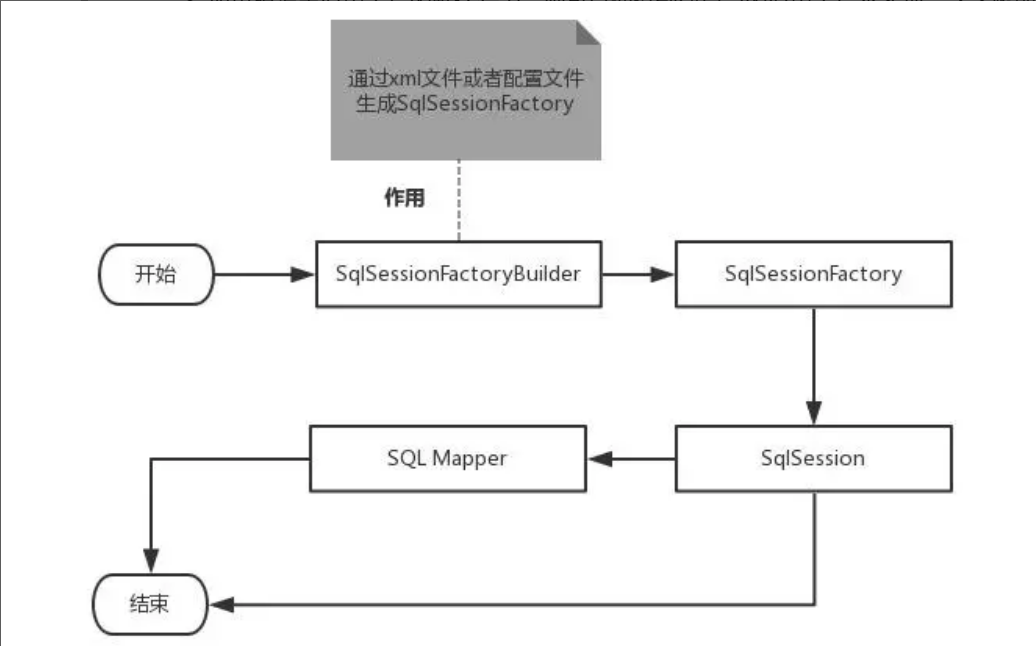
作用域理解
SqlSessionFactoryBuilder 的作用在于创建 SqlSessionFactory,创建成功后,SqlSessionFactoryBuilder 就失去了作用,所以它只能存在于创建 SqlSessionFactory 的方法中,而不要让其长期存在。因此 SqlSessionFactoryBuilder 实例的最佳作用域是方法作用域(也就是局部方法变量)。
SqlSessionFactory 可以被认为是一个数据库连接池,它的作用是创建 SqlSession 接口对象。因为 MyBatis 的本质就是 Java 对数据库的操作,所以 SqlSessionFactory 的生命周期存在于整个 MyBatis 的应用之中,所以一旦创建了 SqlSessionFactory,就要长期保存它,直至不再使用 MyBatis 应用,所以可以认为 SqlSessionFactory 的生命周期就等同于 MyBatis 的应用周期。
由于 SqlSessionFactory 是一个对数据库的连接池,所以它占据着数据库的连接资源。如果创建多个 SqlSessionFactory,那么就存在多个数据库连接池,这样不利于对数据库资源的控制,也会导致数据库连接资源被消耗光,出现系统宕机等情况,所以尽量避免发生这样的情况。
因此在一般的应用中我们往往希望 SqlSessionFactory 作为一个单例,让它在应用中被共享。所以说 SqlSessionFactory 的最佳作用域是应用作用域。
如果说 SqlSessionFactory 相当于数据库连接池,那么 SqlSession 就相当于一个数据库连接(Connection 对象),你可以在一个事务里面执行多条 SQL,然后通过它的 commit、rollback 等方法,提交或者回滚事务。所以它应该存活在一个业务请求中,处理完整个请求后,应该关闭这条连接,让它归还给 SqlSessionFactory,否则数据库资源就很快被耗费精光,系统就会瘫痪,所以用 try…catch…finally… 语句来保证其正确关闭。
所以 SqlSession 的最佳的作用域是请求或方法作用域。
简单来说 SqlSessionFactoryBuilder:
一旦创建了 SqlSessionFactory,就不再需要它了
局部变量
SqlSessionFactory:
说白了就是可以想象为 :数据库连接池
SqlSessionFactory 一旦被创建就应该在应用的运行期间一直存在,没有任何理由丢弃它或重新创建另一个实例。因此 SqlSessionFactory 的最佳作用域是应用作用域。最简单的就是使用单例模式或者静态单例模式。
SqlSession
连接到连接池的一个请求!
SqlSession 的实例不是线程安全的,因此是不能被共享的,所以它的最佳的作用域是请求或方法作用域。
用完之后需要赶紧关闭,否则资源被占用!

五、ResultMap
主要解决字段名和属性名不一致的问题
5.1、 问题引入
当我们的实体类与数据库命名
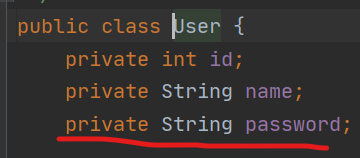
这里的pojo中password与数据库pwd不一致
导致我们测试结果中的password为null,针对这个问题我们有两种解决方法
在sql语句中起别名
<!--根据id查询用户-->
<select id="getUserById" resultType="com.kang.pojo.User">
select id,name,pwd as password from user where id = #{id}
</select>用ResultMap做结果集映射(推荐使用)
<!--结果集映射-->
<resultMap id="UserMap" type="User">
<!--column数据库中的字段,property实体类中的属性-->
<result column="id" property="id"/>
<result column="name" property="name"/>
<result column="pwd" property="password"/>
</resultMap>
<select id="selectUser" resultType="com.kang.pojo.User" resultMap="UserMap">
select * from user
</select>resultMap 元素是 MyBatis 中最重要最强大的元素。它可以让你从 90% 的 JDBC 数据提取代码中解放出来。ResultSets
实际上,在为一些比如连接的复杂语句编写映射代码的时候,一份 能够代替实现同等功能的长达数千行的代码。resultMap
ResultMap 的设计思想是,对于简单的语句根本不需要配置显式的结果映射,而对于复杂一点的语句只需要描述它们的关系就行了。
这里引用一句官网的话:
如果世界总是这么简单就好了。
六、日志工厂
如果一个数据库操作,出现了异常,我们需要排错。日志就是最好的助手!
曾经:sout 、debug
现在:日志工厂!
总的来说,这个日志工厂对我们日后的排错非常重要,一旦代码出错我们可以很快速和方便的发现错误!
这里我们主要介绍两种日志:标准日志和log4j
6.1、 标准日志输出
在Mybatis中具体使用那个一日志实现,在设置中设定!
STDOUT_LOGGING标准日志输出
在mybatis核心配置文件中,配置我们的日志!
<settings>
<!-- 基本日志工厂-->
<!-- <setting name="logImpl" value="STDOUT_LOGGING"/>-->
<setting name="logImpl" value="LOG4J"/>
</settings>这里如果粘贴到config中报错,可能时配置标签的顺序有问题!
测试可以看我们的控制台,输出日志

6.2、log4j
Log4j是Apache的一个开源项目
通过使用Log4j,我们可以控制日志信息输送的目的地:控制台,文本,GUI组件….
我们也可以控制每一条日志的输出格式;
通过定义每一条日志信息的级别,我们能够更加细致地控制日志的生成过程。最令人感兴趣的就是,这些可以通过一个配置文件来灵活地进行配置,而不需要修改应用的代码。
使用步骤:
导入log4j的依赖
<!-- https://mvnrepository.com/artifact/log4j/log4j -->
<dependency>
<groupId>log4j</groupId>
<artifactId>log4j</artifactId>
<version>1.2.17</version>
</dependency>
log4j的properties
#将等级为DEBUG的日志信息输出到console和file这两个目的地,console和file的定义在下面的代码
log4j.rootLogger=DEBUG,console,file
#控制台输出的相关设置
log4j.appender.console = org.apache.log4j.ConsoleAppender
log4j.appender.console.Target = System.out
log4j.appender.console.Threshold=DEBUG
log4j.appender.console.layout = org.apache.log4j.PatternLayout
log4j.appender.console.layout.ConversionPattern=[%c]-%m%n
#文件输出的相关设置
log4j.appender.file = org.apache.log4j.RollingFileAppender
log4j.appender.file.File=./log/kuang.log
log4j.appender.file.MaxFileSize=10mb
log4j.appender.file.Threshold=DEBUG
log4j.appender.file.layout=org.apache.log4j.PatternLayout
log4j.appender.file.layout.ConversionPattern=[%p][%d{yy-MM-dd}][%c]%m%n
#日志输出级别
log4j.logger.org.mybatis=DEBUG
log4j.logger.java.sql=DEBUG
log4j.logger.java.sql.Statement=DEBUG
log4j.logger.java.sql.ResultSet=DEBUG
log4j.logger.java.sql.PreparedStatement=DEBUG
在config中配置log4j
<settings>
<!-- 基本日志-->
<!-- <setting name="logImpl" value="STDOUT_LOGGING"/>-->
<!-- log4j-->
<setting name="logImpl" value="LOG4J"/>
</settings>Log4j的使用!,直接测试运行刚才的查询
测试类
static Logger logger = Logger.getLogger("MyTest");
@Test
public void selectUser() {
logger.info("info:进入selectUser方法");
logger.debug("debug:进入selectUser方法");
logger.error("error: 进入selectUser方法");
//获取sqlSession
SqlSession session = MybatisUtils.getSqlSession();
//获取mapper
UserMapper mapper = session.getMapper(UserMapper.class);
//调用mapper定义的方法
List<User> userList = mapper.selectUser();
for (User user : userList) {
System.out.println(user.toString());
}
session.close();
}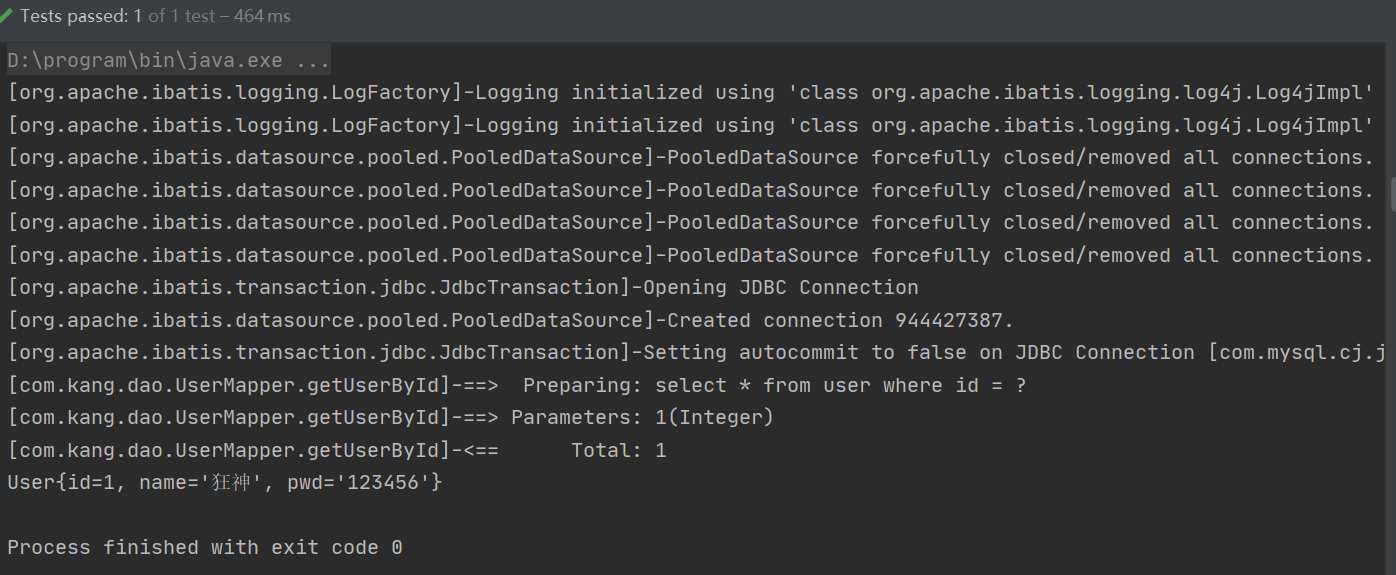
我们在log包下的文件中有详细的日志输出,包括我们在测试类加入的日志
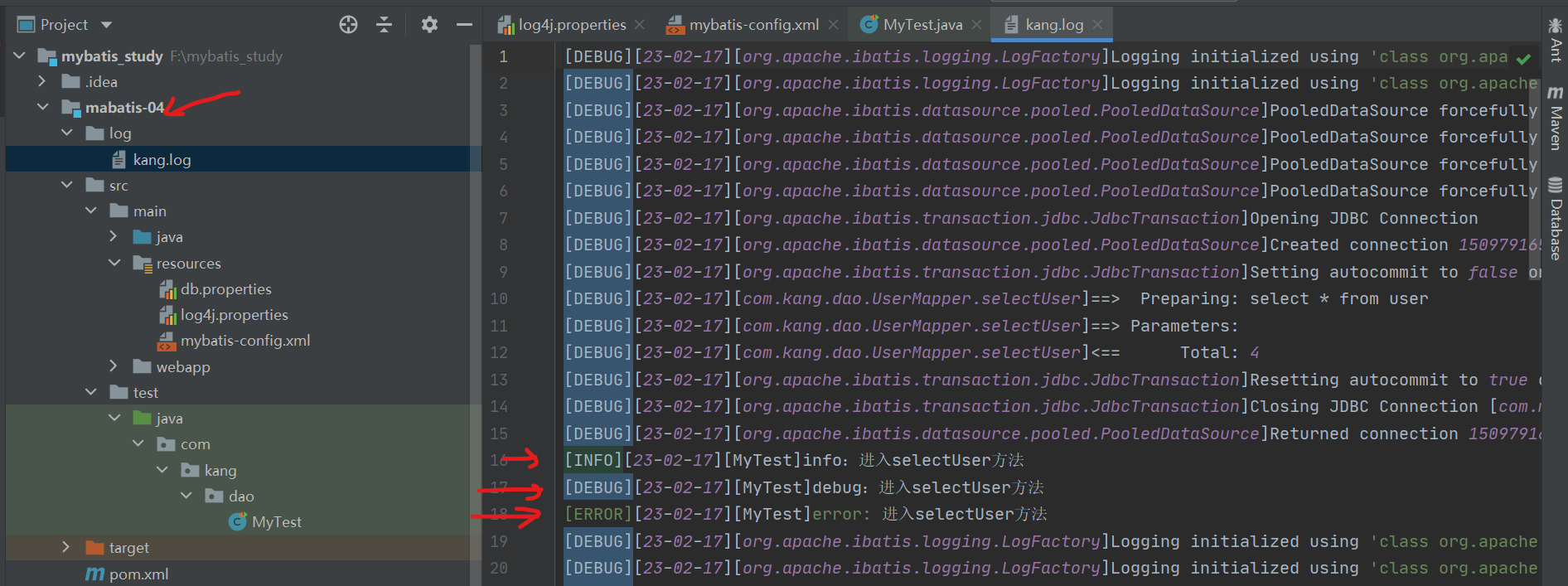
七、分页
思考:为什么需要分页?
在学习mybatis等持久层框架的时候,会经常对数据进行增删改查操作,使用最多的是对数据库进行查询操作,如果查询大量数据的时候,我们往往使用分页进行查询,也就是每次处理小部分数据,这样对数据库压力就在可控范围内。
7.1、 使用limit分页
基本语法:
语法:SELECT * from user limit startIndex,pageSize;
SELECT * from user limit 3; #[0,n]使用Mybatis实现分页,核心SQL
接口
//分页limit
List<User> getUserByLimit(Map<String,Integer> map);Mapper.xml
<!-- limit-->
<select id="getUserByLimit" parameterType="map" resultType="User">
select * from mybatis.user limit #{startIndex},#{pageSize}
</select>测试
@Test
public void getUserByLimit(){
SqlSession sqlSession = MybatisUtils.getSqlSession();
UserMapper mapper = sqlSession.getMapper(UserMapper.class);
HashMap<String, Integer> map = new HashMap<String, Integer>();
map.put("startIndex",1);
map.put("pageSize",2);
List<User> userList = mapper.getUserByLimit(map);
for (User user : userList) {
System.out.println(user);
}
sqlSession.close();
}7.2、 RowBounds分页
不再使用SQL实现分页
接口
//RowBounds() 分页
List<User> getUserByRowBounds();Mapper.xml
<!--分页2-->
<select id="getUserByRowBounds" resultMap="UserMap">
select * from user
</select>测试
@Test
public void getUserByRowBounds(){
SqlSession sqlSession = MybatisUtils.getSqlSession();
//RowBounds实现
RowBounds rowBounds = new RowBounds(1, 2);
//通过Java代码层面实现分页
List<User> userList = sqlSession.selectList("com.kang.dao.UserMapper.getUserByRowBounds",null,rowBounds);
for (User user : userList) {
System.out.println(user);
}
sqlSession.close();
}7.3、 使用分页插件
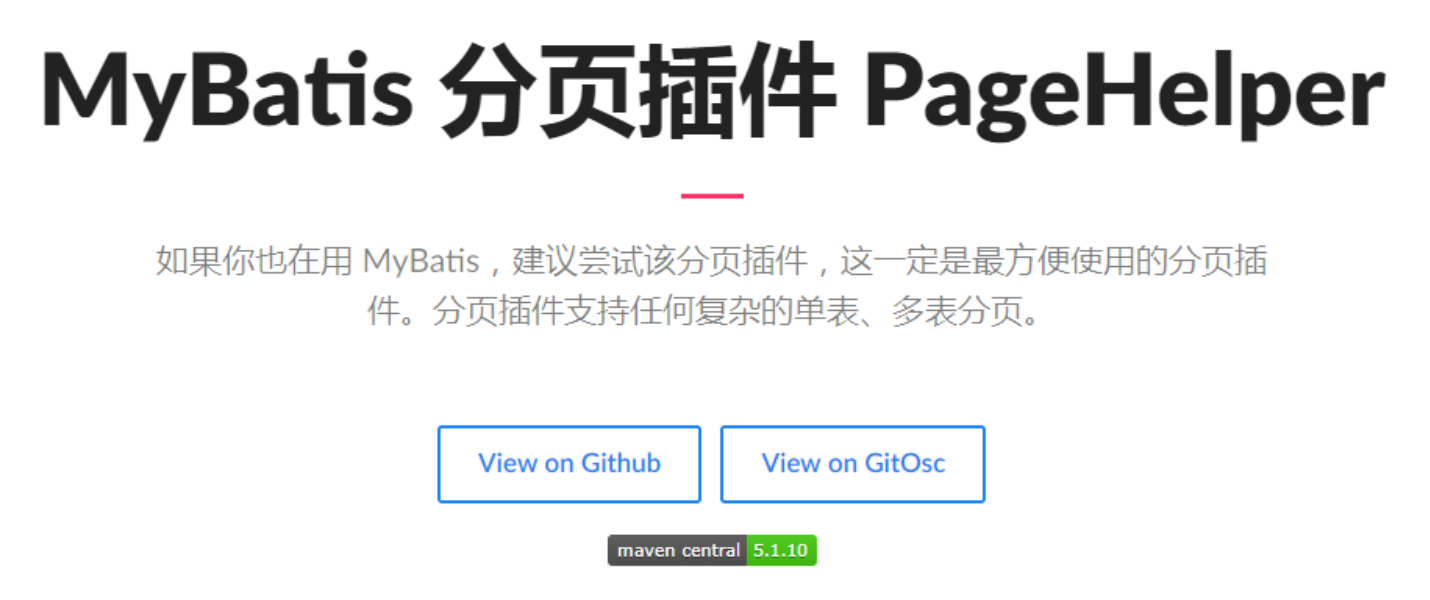
了解即可,可以自己尝试使用
官方文档:https://pagehelper.github.io/
八、使用注解开发
8.1、面向接口编程
- 大家之前都学过面向对象编程,也学习过接口,但在真正的开发中,很多时候我们会选择面向接口编程
- 根本原因 : 解耦 , 可拓展 , 提高复用 , 分层开发中 , 上层不用管具体的实现 , 大家都遵守共同的标准 , 使得开发变得容易 , 规范性更好
- 在一个面向对象的系统中,系统的各种功能是由许许多多的不同对象协作完成的。在这种情况下,各个对象内部是如何实现自己的,对系统设计人员来讲就不那么重要了;
- 而各个对象之间的协作关系则成为系统设计的关键。小到不同类之间的通信,大到各模块之间的交互,在系统设计之初都是要着重考虑的,这也是系统设计的主要工作内容。面向接口编程就是指按照这种思想来编程。
关于接口的理解
- 接口从更深层次的理解,应是定义(规范,约束)与实现(名实分离的原则)的分离。
- 接口的本身反映了系统设计人员对系统的抽象理解。
- 接口应有两类:
- 第一类是对一个个体的抽象,它可对应为一个抽象体(abstract class);
- 第二类是对一个个体某一方面的抽象,即形成一个抽象面(interface);
- 一个体有可能有多个抽象面。抽象体与抽象面是有区别的。
三个面向区别
- 面向对象是指,我们考虑问题时,以对象为单位,考虑它的属性及方法 .
- 面向过程是指,我们考虑问题时,以一个具体的流程(事务过程)为单位,考虑它的实现 .
- 接口设计与非接口设计是针对复用技术而言的,与面向对象(过程)不是一个问题.更多的体现就是对系统整体的架构
8.2、使用注解开发
注解在接口上实现
//查询全部用户
@Select("select id,name,pwd password from user")
public List<User> getAllUser();测试
@Test
public void testGetAllUser() {
SqlSession session = MybatisUtils.getSession();
//本质上利用了jvm的动态代理机制
UserMapper mapper = session.getMapper(UserMapper.class);
● List<User> users = mapper.getAllUser();
for (User user : users){
System.out.println(user);
}
session.close();
}本质上利用了jvm的动态代理机制
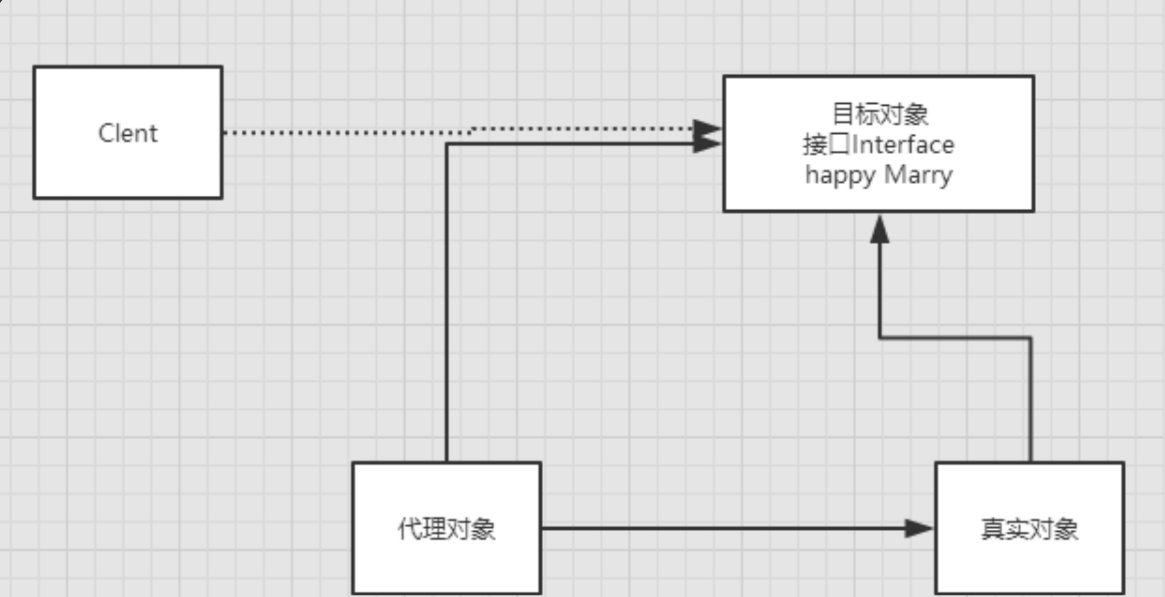
Mybatis详细的执行流程
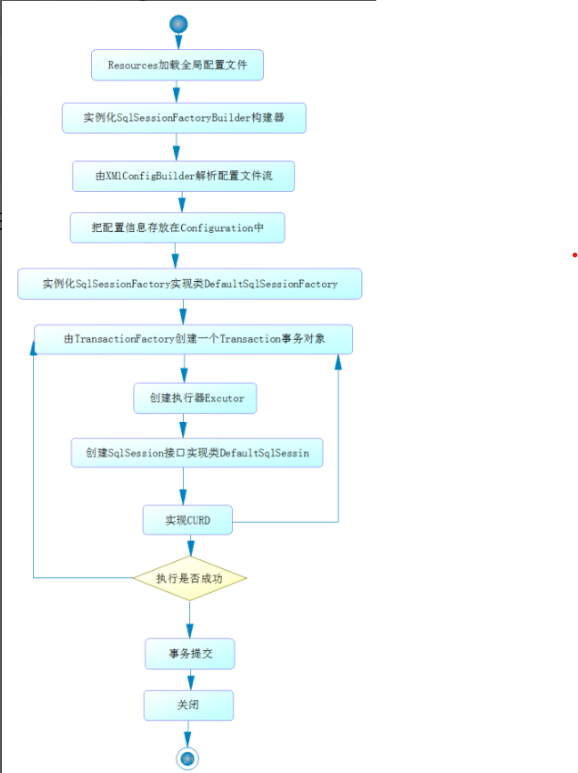
8.3 CRUD
我们可以在工具类中设置事物自动提交
public static SqlSession getSqlSession(){
return sqlSessionFactory.openSession(true);
}
编写接口,添加注解
public interface UserMapper {
@Select("select * from user")
List<User> getUsers();
// 方法存在多个参数,所有的参数前面必须加上 @Param("id")注解
@Select("select * from user where id = #{id}")
User getUserByID(@Param("id") int id);
@Insert("insert into user(id,name,pwd) values (#{id},#{name},#{password})")
int addUser(User user);
@Update("update user set name=#{name},pwd=#{password} where id = #{id}")
int updateUser(User user);
@Delete("delete from user where id = #{uid}")
int deleteUser(@Param("uid") int id);
}
8.3、关于@Param() 注解
基本类型的参数或者String类型,需要加上
引用类型不需要加
如果只有一个基本类型的话,可以忽略,但是建议大家都加上!
我们在SQL中引用的就是我们这里的 @Param() 中设定的属性名!
8.4、#{} ${} 区别
网上看到了一篇讲解#{} ${} 区别,写的非常好!!!
1.#{}是预编译处理,是占位符,${}是字符串替换,是拼接符。
2.Mybatis在处理#{}的时候会将sql中的#{}替换成?号,调用PreparedStatement来赋值
#{}将传入的数据当作一个字符串,会对传入的数据加上一个双引号。
比如,select * from student where student_name = #{studentName}
如果传入的值为xiaoming,那么解析成sql的值为student_name="xiaoming"。
3.Mybatis在处理${}的时候就是把${}替换成变量的值,调用Statement来赋值
${}将传入的数据直接显示生成在sql中;
如:select ${fieldNmae} from student where student_age = 18
传入的参数作为要查询的字段,如果传入的值为student_name,则解析成的sql为:
select student_name from student where age = 18
4. #{}方式能够很大程度上防止sql注入。
5.${}无法防止sql注入。
6.${}方式一般用于传入数据库对象,例如列表和表名。
7.由于#{}方式具有更高的安全行,所以能用#{}的地方尽量不要使用${}。
8.Mybatis排序时使用order by动态参数时需要注意,用${}而不是#{}。
原文链接:https://blog.csdn.net/weixin_50977434/article/details/127782942
以下时狂神总结的#{} ${} 区别
8.4、Lombok
简化我们实体类
使用步骤:
在idea中安装插件

项目导入lombok的jar包
<dependency>
<groupId>org.projectlombok</groupId>
<artifactId>lombok</artifactId>
<version>1.18.10</version>
</dependency>
在实体类上加入注解
@Data:无参构造,get、set、tostring、hashcode,equals
@AllArgsConstructor
@NoArgsConstructor
@EqualsAndHashCode
@ToString
@Getter九、多对一
多个学生,对应一个老师
对于学生这边而言, 关联 .. 多个学生,关联一个老师 【多对一】
对于老师而言, 集合 , 一个老师,有很多学生 【一对多】
环境搭建:
SQL:
CREATE TABLE `teacher` (
`id` INT(10) NOT NULL,
`name` VARCHAR(30) DEFAULT NULL,
PRIMARY KEY (`id`)
) ENGINE=INNODB DEFAULT CHARSET=utf8
INSERT INTO teacher(`id`, `name`) VALUES (1, '秦老师');
CREATE TABLE `student` (
`id` INT(10) NOT NULL,
`name` VARCHAR(30) DEFAULT NULL,
`tid` INT(10) DEFAULT NULL,
PRIMARY KEY (`id`),
KEY `fktid` (`tid`),
CONSTRAINT `fktid` FOREIGN KEY (`tid`) REFERENCES `teacher` (`id`)
) ENGINE=INNODB DEFAULT CHARSET=utf8
INSERT INTO `student` (`id`, `name`, `tid`) VALUES ('1', '小明', '1');
INSERT INTO `student` (`id`, `name`, `tid`) VALUES ('2', '小红', '1');
INSERT INTO `student` (`id`, `name`, `tid`) VALUES ('3', '小张', '1');
INSERT INTO `student` (`id`, `name`, `tid`) VALUES ('4', '小李', '1');
INSERT INTO `student` (`id`, `name`, `tid`) VALUES ('5', '小王', '1');
测试搭建环境:
导入lombok
新建实体类 Teacher,Student
@Data //GET,SET,ToString,有参,无参构造
public class Teacher {
private int id;
private String name;
} @Data
public class Student {
private int id;
private String name;
//多个学生可以是同一个老师,即多对一
private Teacher teacher;
}建立Mapper接口
建立Mapper.XML文件
在核心配置文件中绑定注册我们的Mapper接口或者文件!【方式很多,随心选】
测试查询是否能够成功!
9.1、安装查询嵌套处理
<!--
思路:
1. 查询所有的学生信息
2. 根据查询出来的学生的tid,寻找对应的老师! 子查询
-->
<select id="getStudent" resultMap="StudentTeacher">
select * from student
</select>
<resultMap id="StudentTeacher" type="Student">
<result property="id" column="id"/>
<result property="name" column="name"/>
<!--复杂的属性,我们需要单独处理 对象: association 集合: collection -->
<association property="teacher" column="tid" javaType="Teacher" select="getTeacher"/>
</resultMap>
<select id="getTeacher" resultType="Teacher">
select * from teacher where id = #{id}
</select>当时学到这里,突然忘了property的属性是干什么的?
又从头复习了一遍,property代表了pojo里的属性名。
9.2、按照结果嵌套处理
<!--按照结果嵌套处理-->
<select id="getStudent2" resultMap="StudentTeacher2">
select s.id sid,s.name sname,t.name tname
from student s,teacher t
where s.tid = t.id;
</select>
<resultMap id="StudentTeacher2" type="Student">
<result property="id" column="sid"/>
<result property="name" column="sname"/>
<association property="teacher" javaType="Teacher">
<result property="name" column="tname"/>
</association>
</resultMap>
回顾Mysql 多对一查询方式:
子查询
联表查询
这里我感觉的确是按照结果嵌套查询比较容易理解,逻辑也比较清晰。
十、一对多
比如:一个老师拥有多个学生!
对于老师而言,就是一对多的关系!
搭建环境同上
实体类
@Data
public class Student {
private int id;
private String name;
private int tid;
}@Data
public class Teacher {
private int id;
private String name;
//一个老师拥有多个学生
private List<Student> students;
}
10.1、按照查询嵌套处理
<select id="getTeacher2" resultMap="TeacherStudent2">
select * from mybatis.teacher where id = #{tid}
</select>
<resultMap id="TeacherStudent2" type="Teacher">
<collection property="students" javaType="ArrayList" ofType="Student" select="getStudentByTeacherId" column="id"/>
</resultMap>
<select id="getStudentByTeacherId" resultType="Student">
select * from mybatis.student where tid = #{tid}
</select>
10.2、按照结果嵌套处理
<!--按结果嵌套查询-->
<select id="getTeacher" resultMap="TeacherStudent">
select s.id sid, s.name sname, t.name tname,t.id tid
from student s,teacher t
where s.tid = t.id and t.id = #{tid}
</select>
<resultMap id="TeacherStudent" type="Teacher">
<result property="id" column="tid"/>
<result property="name" column="tname"/>
<!--复杂的属性,我们需要单独处理 对象: association 集合: collection
javaType="" 指定属性的类型!
集合中的泛型信息,我们使用ofType获取
-->
<collection property="students" ofType="Student">
<result property="id" column="sid"/>
<result property="name" column="sname"/>
<result property="tid" column="tid"/>
</collection>
</resultMap>
10.3 小结
关联-association
集合-collection
所以association是用于一对一和多对一,而collection是用于一对多的关系
JavaType和ofType都是用来指定对象类型的
JavaType是用来指定pojo中属性的类型
ofType指定的是映射到list集合属性中pojo的类型。
注意说明:
保证SQL的可读性,尽量通俗易懂
根据实际要求,尽量编写性能更高的SQL语句
注意属性名和字段不一致的问题
注意一对多和多对一 中:字段和属性对应的问题
尽量使用Log4j,通过日志来查看自己的错误
面试高频
Mysql引擎
InnoDB底层原理
索引
索引优化!
十一、动态SQL
11.1 介绍
什么是动态SQL:动态SQL指的是根据不同的查询条件 , 生成不同的Sql语句.
官网描述:
MyBatis 的强大特性之一便是它的动态 SQL。如果你有使用 JDBC 或其它类似框架的经验,你就能体会到根据不同条件拼接 SQL 语句的痛苦。例如拼接时要确保不能忘记添加必要的空格,还要注意去掉列表最后一个列名的逗号。利用动态 SQL 这一特性可以彻底摆脱这种痛苦。
虽然在以前使用动态 SQL 并非一件易事,但正是 MyBatis 提供了可以被用在任意 SQL 映射语句中的强大的动态 SQL 语言得以改进这种情形。
动态 SQL 元素和 JSTL 或基于类似 XML 的文本处理器相似。在 MyBatis 之前的版本中,有很多元素需要花时间了解。MyBatis 3 大大精简了元素种类,现在只需学习原来一半的元素便可。MyBatis 采用功能强大的基于 OGNL 的表达式来淘汰其它大部分元素。
-------------------------------
- if
- choose (when, otherwise)
- trim (where, set)
- foreach
-------------------------------我们之前写的 SQL 语句都比较简单,如果有比较复杂的业务,我们需要写复杂的 SQL 语句,往往需要拼接,而拼接 SQL ,稍微不注意,由于引号,空格等缺失可能都会导致错误。
那么怎么去解决这个问题呢?这就要使用 mybatis 动态SQL,通过 if, choose, when, otherwise, trim, where, set, foreach等标签,可组合成非常灵活的SQL语句,从而在提高 SQL 语句的准确性的同时,也大大提高了开发人员的效率。
搭建环境:
SQL:
CREATE TABLE `blog` (
`id` varchar(50) NOT NULL COMMENT '博客id',
`title` varchar(100) NOT NULL COMMENT '博客标题',
`author` varchar(30) NOT NULL COMMENT '博客作者',
`create_time` datetime NOT NULL COMMENT '创建时间',
`views` int(30) NOT NULL COMMENT '浏览量'
) ENGINE=InnoDB DEFAULT CHARSET=utf8
这里在以前的框架中导入IDutil工具类
public class IDUtil {
public static String genId(){
return UUID.randomUUID().toString().replaceAll("-","");
}
}创建一个基础工程
导包
编写配置文件
编写实体类
@Data
public class Blog {
private int id;
private String title;
private String author;
private Date createTime;
private int views;
}
编写实体类对应Mapper接口 和 Mapper.XML文件
插入原始数据
接口
@Insert("insert into blog (id, title, author, create_time, views)\n" +
" values (#{id},#{title},#{author},#{createTime},#{views})")
int addBlog(Blog blog);测试类
@Test
public void addInitBlog(){
SqlSession session = MybatisUtils.getSqlSession();
BlogMapper mapper = session.getMapper(BlogMapper.class);
Blog blog = new Blog();
blog.setId(IDutil.genId());
blog.setTitle("Mybatis如此简单");
blog.setAuthor("狂神说");
blog.setCreateTime(new Date());
blog.setViews(9999);
mapper.addBlog(blog);
blog.setId(IDutil.genId());
blog.setTitle("Java如此简单");
mapper.addBlog(blog);
blog.setId(IDutil.genId());
blog.setTitle("Spring如此简单");
mapper.addBlog(blog);
blog.setId(IDutil.genId());
blog.setTitle("微服务如此简单");
mapper.addBlog(blog);
session.commit();
session.close();
}10.2、if 语句
需求:根据作者名字和博客名字来查询博客!如果作者名字为空,那么只根据博客名字查询,反之,则根据作者名来查询
编写接口类
//需求1
List<Blog> queryBlogIf(Map map);编写SQL语句
<!--需求1:
根据作者名字和博客名字来查询博客!
如果作者名字为空,那么只根据博客名字查询,反之,则根据作者名来查询
select * from blog where title = #{title} and author = #{author}
-->
<select id="queryBlogIf" parameterType="map" resultType="blog">
select * from blog where
<if test="title != null">
title = #{title}
</if>
<if test="author != null">
and author = #{author}
</if>
</select>测试
@Test
public void testQueryBlogIf(){
SqlSession session = MybatisUtils.getSession();
BlogMapper mapper = session.getMapper(BlogMapper.class);
HashMap<String, String> map = new HashMap<String, String>();
map.put("title","Mybatis如此简单");
map.put("author","狂神说");
List<Blog> blogs = mapper.queryBlogIf(map);
System.out.println(blogs);
session.close();
}这样写我们可以看到,如果 author 等于 null,那么查询语句为 select from user where title=#{title},但是如果title为空呢?那么查询语句为 select from user where and author=#{author},这是错误的 SQL 语句,如何解决呢?请看下面的 where 语句!
10.3、Where
修改上面的SQL语句;
<select id="queryBlogIf" parameterType="map" resultType="blog">
select * from blog
<where>
<if test="title != null">
title = #{title}
</if>
<if test="author != null">
and author = #{author}
</if>
</where>
</select>这个“where”标签会知道如果它包含的标签中有返回值的话,它就插入一个‘where’。此外,如果标签返回的内容是以AND 或OR 开头的,则它会剔除掉。【这是我们使用的最多的案例】
10.4、Set
同理,上面的对于查询 SQL 语句包含 where 关键字,如果在进行更新操作的时候,含有 set 关键词,我们怎么处理呢?
编写接口方法
int updateBlog(Map map);sql配置文件
<!--注意set是用的逗号隔开-->
<update id="updateBlog" parameterType="map">
update blog
<set>
<if test="title != null">
title = #{title},
</if>
<if test="author != null">
author = #{author}
</if>
</set>
where id = #{id};
</update>测试
@Test
public void testUpdateBlog(){
SqlSession session = MybatisUtils.getSession();
BlogMapper mapper = session.getMapper(BlogMapper.class);
HashMap<String, String> map = new HashMap<String, String>();
map.put("title","动态SQL");
map.put("author","秦疆");
map.put("id","9d6a763f5e1347cebda43e2a32687a77");
mapper.updateBlog(map);
session.close();
}10.5、choose语句
有时候,我们不想用到所有的查询条件,只想选择其中的一个,查询条件有一个满足即可,使用 choose 标签可以解决此类问题,类似于 Java 的 switch 语句
1. 编写接口方法
List<Blog> queryBlogChoose(Map map);sql配置文件
<select id="queryBlogChoose" parameterType="map" resultType="blog">
select * from blog
<where>
<choose>
<when test="title != null">
title = #{title}
</when>
<when test="author != null">
and author = #{author}
</when>
<otherwise>
and views = #{views}
</otherwise>
</choose>
</where>
</select>测试类
@Test
public void testQueryBlogChoose(){
SqlSession session = MybatisUtils.getSession();
BlogMapper mapper = session.getMapper(BlogMapper.class);
HashMap<String, Object> map = new HashMap<String, Object>();
map.put("title","Java如此简单");
map.put("author","狂神说");
map.put("views",9999);
List<Blog> blogs = mapper.queryBlogChoose(map);
System.out.println(blogs);
session.close();
}10.6、SQL片段
有时候可能某个 sql 语句我们用的特别多,为了增加代码的重用性,简化代码,我们需要将这些代码抽取出来,然后使用时直接调用。
提取SQL片段:
<sql id="if-title-author">
<if test="title != null">
title = #{title}
</if>
<if test="author != null">
and author = #{author}
</if>
</sql>引用SQL片段:
<select id="queryBlogIf" parameterType="map" resultType="blog">
select * from blog
<where>
<!-- 引用 sql 片段,如果refid 指定的不在本文件中,那么需要在前面加上 namespace -->
<include refid="if-title-author"></include>
<!-- 在这里还可以引用其他的 sql 片段 -->
</where>
</select>注意:①、最好基于 单表来定义 sql 片段,提高片段的可重用性
②、在 sql 片段中不要包括 where
10.7、Foreach
将数据库中前三个数据的id修改为1,2,3;
需求:我们需要查询 blog 表中 id 分别为1,2,3的博客信息
编写接口
List<Blog> queryBlogForeach(Map map);编写SQL语句
<select id="queryBlogForeach" parameterType="map" resultType="blog">
select * from blog
<where>
<!--
collection:指定输入对象中的集合属性
item:每次遍历生成的对象
open:开始遍历时的拼接字符串
close:结束时拼接的字符串
separator:遍历对象之间需要拼接的字符串
select * from blog where 1=1 and (id=1 or id=2 or id=3)
-->
<foreach collection="ids" item="id" open="and (" close=")" separator="or">
id=#{id}
</foreach>
</where>
</select>测试
@Test
public void testQueryBlogForeach(){
SqlSession session = MybatisUtils.getSession();
BlogMapper mapper = session.getMapper(BlogMapper.class);
HashMap map = new HashMap();
List<Integer> ids = new ArrayList<Integer>();
ids.add(1);
ids.add(2);
ids.add(3);
map.put("ids",ids);
List<Blog> blogs = mapper.queryBlogForeach(map);
System.out.println(blogs);
session.close();
}小结:其实动态 sql 语句的编写往往就是一个拼接的问题,为了保证拼接准确,我们最好首先要写原生的 sql 语句出来,然后在通过 mybatis 动态sql 对照着改,防止出错。多在实践中使用才是熟练掌握它的技巧
十二、缓存
12.1、简介
什么是缓存 [ Cache ]?
存在内存中的临时数据。
将用户经常查询的数据放在缓存(内存)中,用户去查询数据就不用从磁盘上(关系型数据库数据文件)查询,从缓存中查询,从而提高查询效率,解决了高并发系统的性能问题。
为什么使用缓存?
减少和数据库的交互次数,减少系统开销,提高系统效率。
什么样的数据能使用缓存?
经常查询并且不经常改变的数据。
12.2、Mybatis缓存
MyBatis包含一个非常强大的查询缓存特性,它可以非常方便地定制和配置缓存。缓存可以极大的提升查询效率。
MyBatis系统中默认定义了两级缓存:一级缓存和二级缓存
默认情况下,只有一级缓存开启。(SqlSession级别的缓存,也称为本地缓存)
二级缓存需要手动开启和配置,他是基于namespace级别的缓存。
为了提高扩展性,MyBatis定义了缓存接口Cache。我们可以通过实现Cache接口来自定义二级缓存
12.3、一级缓存
一级缓存也叫本地缓存:
与数据库同一次会话期间查询到的数据会放在本地缓存中。
以后如果需要获取相同的数据,直接从缓存中拿,没必须再去查询数据库;
12.3.1、初体验测试
在mybatis中加入日志,方便测试结果
编写接口方法
//根据id查询用户
User queryUserById(@Param("id") int id);接口对应的Mapper文件
<select id="queryUserById" resultType="user">
select * from user where id = #{id}
</select>测试
@Test
public void testQueryUserById(){
SqlSession session = MybatisUtils.getSession();
UserMapper mapper = session.getMapper(UserMapper.class);
User user = mapper.queryUserById(1);
System.out.println(user);
User user2 = mapper.queryUserById(1);
System.out.println(user2);
System.out.println(user==user2);
session.close();
}结果分析
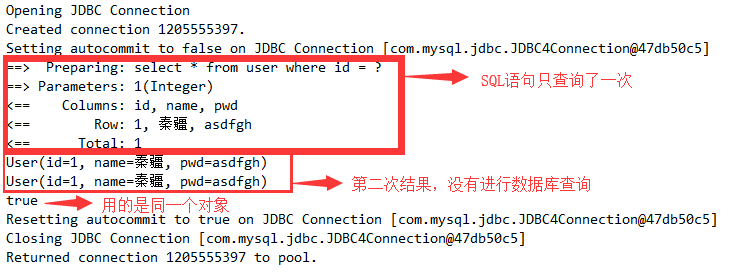
12.3.2、一级缓存失效的四种情况
一级缓存是SqlSession级别的缓存,是一直开启的,我们关闭不了它;
一级缓存失效情况:没有使用到当前的一级缓存,效果就是,还需要再向数据库中发起一次查询请求!
sqlSession不同
@Test
public void testQueryUserById(){
SqlSession session = MybatisUtils.getSession();
SqlSession session2 = MybatisUtils.getSession();
UserMapper mapper = session.getMapper(UserMapper.class);
UserMapper mapper2 = session2.getMapper(UserMapper.class);
User user = mapper.queryUserById(1);
System.out.println(user);
User user2 = mapper2.queryUserById(1);
System.out.println(user2);
System.out.println(user==user2);
session.close();
session2.close();
}观察结果:发现发送了两条SQL语句!
结论:每个sqlSession中的缓存相互独立
sqlSession相同,查询条件不同
@Test
public void testQueryUserById(){
SqlSession session = MybatisUtils.getSession();
UserMapper mapper = session.getMapper(UserMapper.class);
UserMapper mapper2 = session.getMapper(UserMapper.class);
User user = mapper.queryUserById(1);
System.out.println(user);
User user2 = mapper2.queryUserById(2);
System.out.println(user2);
System.out.println(user==user2);
session.close();
}观察结果:发现发送了两条SQL语句!很正常的理解
结论:当前缓存中,不存在这个数据
sqlSession相同,两次查询之间执行了增删改操作!
增加方法
//修改用户
int updateUser(Map map);编写SQL
<update id="updateUser" parameterType="map">
update user set name = #{name} where id = #{id}
</update>测试
@Test
public void testQueryUserById(){
SqlSession session = MybatisUtils.getSession();
UserMapper mapper = session.getMapper(UserMapper.class);
User user = mapper.queryUserById(1);
System.out.println(user);
HashMap map = new HashMap();
map.put("name","kuangshen");
map.put("id",4);
mapper.updateUser(map);
User user2 = mapper.queryUserById(1);
System.out.println(user2);
System.out.println(user==user2);
session.close();
}观察结果:查询在中间执行了增删改操作后,重新执行了
结论:因为增删改操作可能会对当前数据产生影响
sqlSession相同,手动清除一级缓存
@Test
public void testQueryUserById(){
SqlSession session = MybatisUtils.getSession();
UserMapper mapper = session.getMapper(UserMapper.class);
User user = mapper.queryUserById(1);
System.out.println(user);
session.clearCache();//手动清除缓存
User user2 = mapper.queryUserById(1);
System.out.println(user2);
System.out.println(user==user2);
session.close();
}一级缓存就是一个map
11.4、二级缓存
二级缓存也叫全局缓存,一级缓存作用域太低了,所以诞生了二级缓存
基于namespace级别的缓存,一个名称空间,对应一个二级缓存;
工作机制
一个会话查询一条数据,这个数据就会被放在当前会话的一级缓存中;
如果当前会话关闭了,这个会话对应的一级缓存就没了;但是我们想要的是,会话关闭了,一级缓存中的数据被保存到二级缓存中;
新的会话查询信息,就可以从二级缓存中获取内容;
不同的mapper查出的数据会放在自己对应的缓存(map)中;
11.4.1、使用步骤
官方文档
开启全局缓存 【mybatis-config.xml】
<setting name="cacheEnabled" value="true"/>去每个mapper.xml中配置使用二级缓存,这个配置非常简单;【xxxMapper.xml】
<cache/>官方示例=====>查看官方文档
<cache
eviction="FIFO"
flushInterval="60000"
size="512"
readOnly="true"/>这个更高级的配置创建了一个 FIFO 缓存,每隔 60 秒刷新,最多可以存储结果对象或列表的 512 个引用,而且返回的对象被认为是只读的,因此对它们进行修改可能会在不同线程中的调用者产生冲突。
代码测试
所有的实体类先实现序列化接口
测试代码
@Test
public void testQueryUserById(){
SqlSession session = MybatisUtils.getSession();
SqlSession session2 = MybatisUtils.getSession();
UserMapper mapper = session.getMapper(UserMapper.class);
UserMapper mapper2 = session2.getMapper(UserMapper.class);
User user = mapper.queryUserById(1);
System.out.println(user);
session.close();
User user2 = mapper2.queryUserById(1);
System.out.println(user2);
System.out.println(user==user2);
session2.close();
}11.4.2、结论
只要开启了二级缓存,我们在同一个Mapper中的查询,可以在二级缓存中拿到数据
查出的数据都会被默认先放在一级缓存中
只有会话提交或者关闭以后,一级缓存中的数据才会转到二级缓存中
11.5、缓存原理
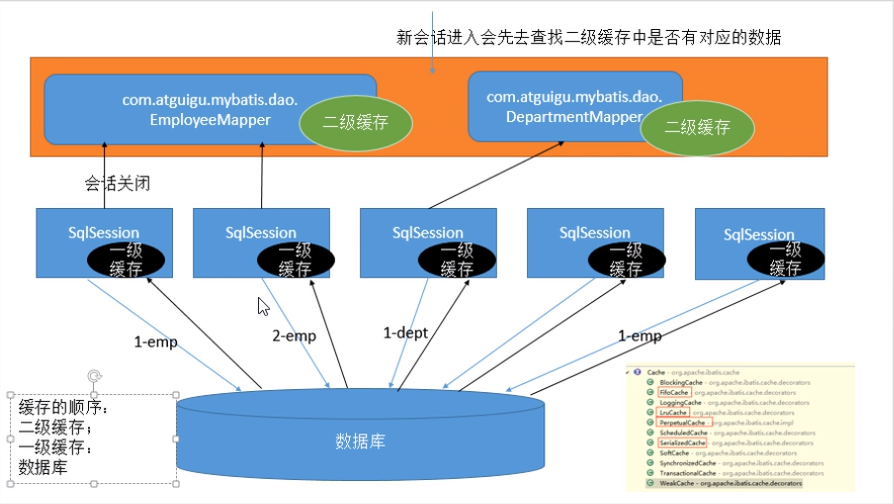
11.6、EhCache
第三方缓存实现—EhCache: 查看百度百科
官方文档
Ehcache是一种广泛使用的java分布式缓存,用于通用缓存;
要在应用程序中使用Ehcache,需要引入依赖的jar包
<!-- https://mvnrepository.com/artifact/org.mybatis.caches/mybatis-ehcache -->
<dependency>
<groupId>org.mybatis.caches</groupId>
<artifactId>mybatis-ehcache</artifactId>
<version>1.1.0</version>
</dependency>在mapper.xml中使用对应的缓存即可
<mapper namespace = “org.acme.FooMapper” >
<cache type = “org.mybatis.caches.ehcache.EhcacheCache” />
</mapper>编写ehcache.xml文件,如果在加载时未找到/ehcache.xml资源或出现问题,则将使用默认配置。
<?xml version="1.0" encoding="UTF-8"?>
<ehcache xmlns:xsi="http://www.w3.org/2001/XMLSchema-instance"
xsi:noNamespaceSchemaLocation="http://ehcache.org/ehcache.xsd"
updateCheck="false">
<!--
diskStore:为缓存路径,ehcache分为内存和磁盘两级,此属性定义磁盘的缓存位置。参数解释如下:
user.home – 用户主目录
user.dir – 用户当前工作目录
java.io.tmpdir – 默认临时文件路径
-->
<diskStore path="./tmpdir/Tmp_EhCache"/>
<defaultCache
eternal="false"
maxElementsInMemory="10000"
overflowToDisk="false"
diskPersistent="false"
timeToIdleSeconds="1800"
timeToLiveSeconds="259200"
memoryStoreEvictionPolicy="LRU"/>
<cache
name="cloud_user"
eternal="false"
maxElementsInMemory="5000"
overflowToDisk="false"
diskPersistent="false"
timeToIdleSeconds="1800"
timeToLiveSeconds="1800"
memoryStoreEvictionPolicy="LRU"/>
<!--
defaultCache:默认缓存策略,当ehcache找不到定义的缓存时,则使用这个缓存策略。只能定义一个。
-->
<!--
name:缓存名称。
maxElementsInMemory:缓存最大数目
maxElementsOnDisk:硬盘最大缓存个数。
eternal:对象是否永久有效,一但设置了,timeout将不起作用。
overflowToDisk:是否保存到磁盘,当系统当机时
timeToIdleSeconds:设置对象在失效前的允许闲置时间(单位:秒)。仅当eternal=false对象不是永久有效时使用,可选属性,默认值是0,也就是可闲置时间无穷大。
timeToLiveSeconds:设置对象在失效前允许存活时间(单位:秒)。最大时间介于创建时间和失效时间之间。仅当eternal=false对象不是永久有效时使用,默认是0.,也就是对象存活时间无穷大。
diskPersistent:是否缓存虚拟机重启期数据 Whether the disk store persists between restarts of the Virtual Machine. The default value is false.
diskSpoolBufferSizeMB:这个参数设置DiskStore(磁盘缓存)的缓存区大小。默认是30MB。每个Cache都应该有自己的一个缓冲区。
diskExpiryThreadIntervalSeconds:磁盘失效线程运行时间间隔,默认是120秒。
memoryStoreEvictionPolicy:当达到maxElementsInMemory限制时,Ehcache将会根据指定的策略去清理内存。默认策略是LRU(最近最少使用)。你可以设置为FIFO(先进先出)或是LFU(较少使用)。
clearOnFlush:内存数量最大时是否清除。
memoryStoreEvictionPolicy:可选策略有:LRU(最近最少使用,默认策略)、FIFO(先进先出)、LFU(最少访问次数)。
FIFO,first in first out,这个是大家最熟的,先进先出。
LFU, Less Frequently Used,就是上面例子中使用的策略,直白一点就是讲一直以来最少被使用的。如上面所讲,缓存的元素有一个hit属性,hit值最小的将会被清出缓存。
LRU,Least Recently Used,最近最少使用的,缓存的元素有一个时间戳,当缓存容量满了,而又需要腾出地方来缓存新的元素的时候,那么现有缓存元素中时间戳离当前时间最远的元素将被清出缓存。
-->
</ehcache>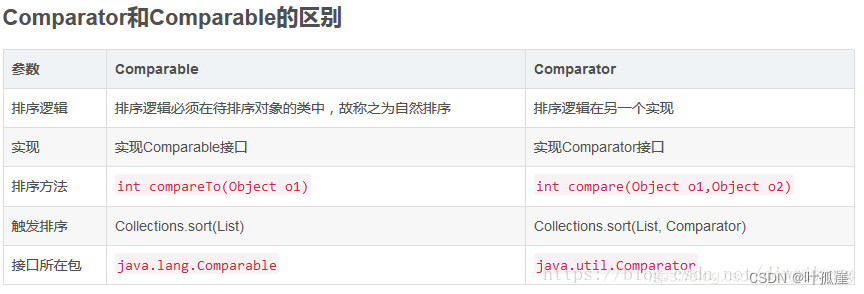
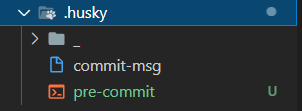

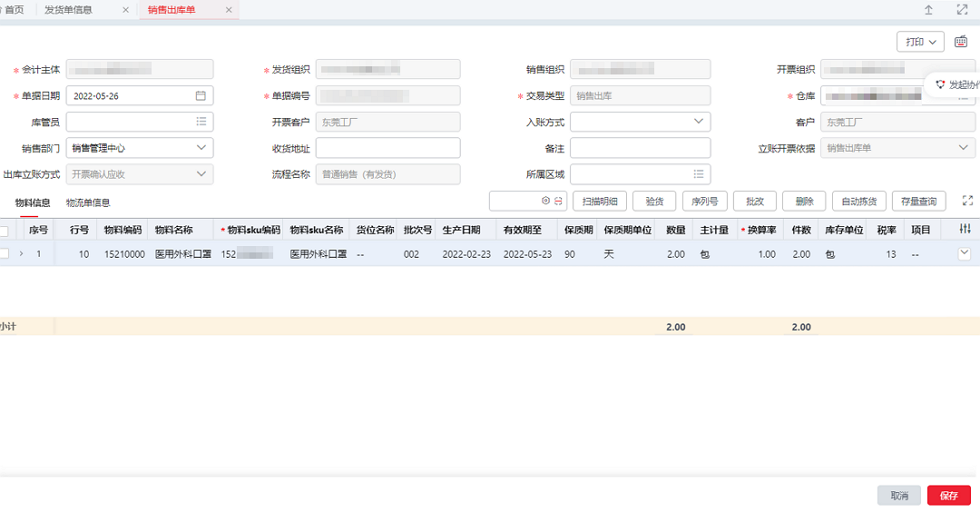
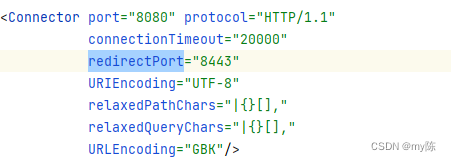
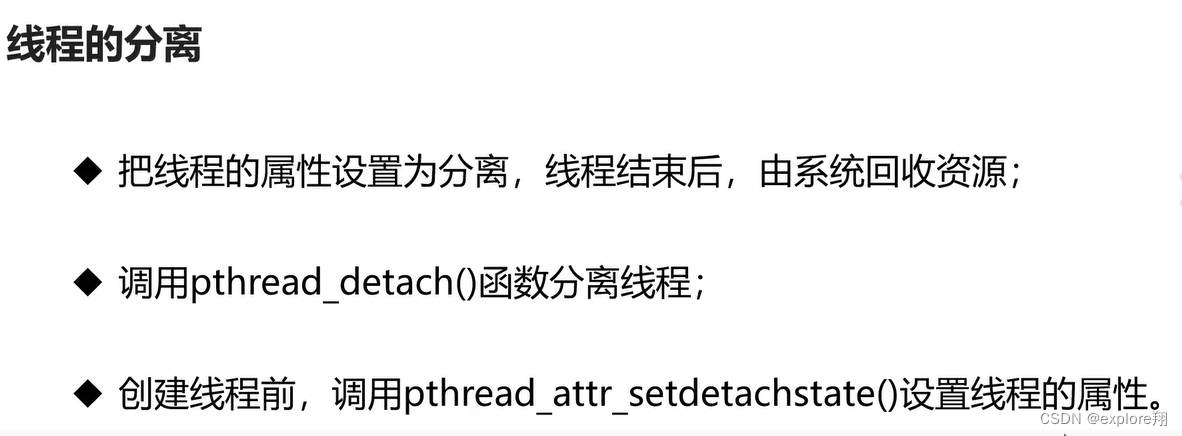
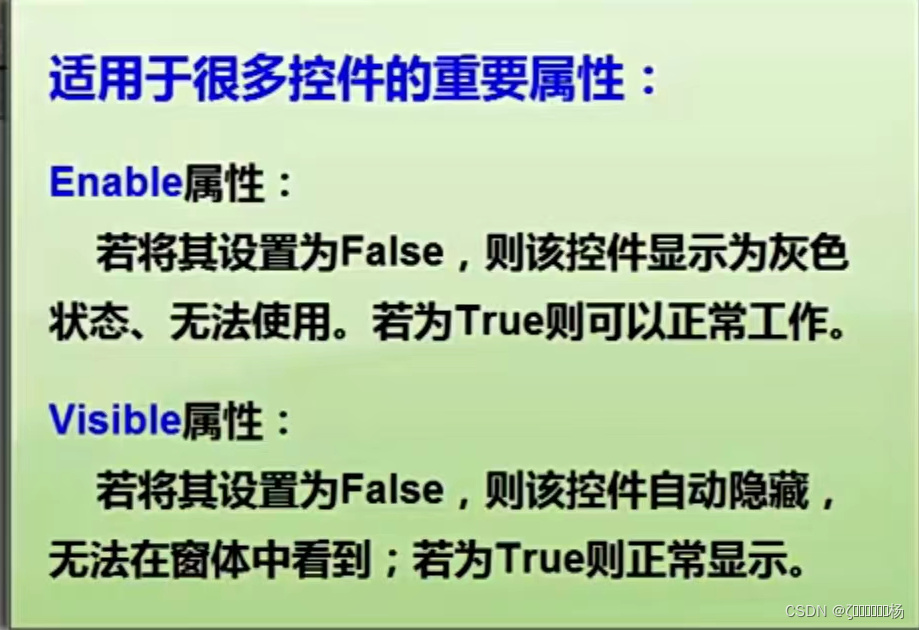
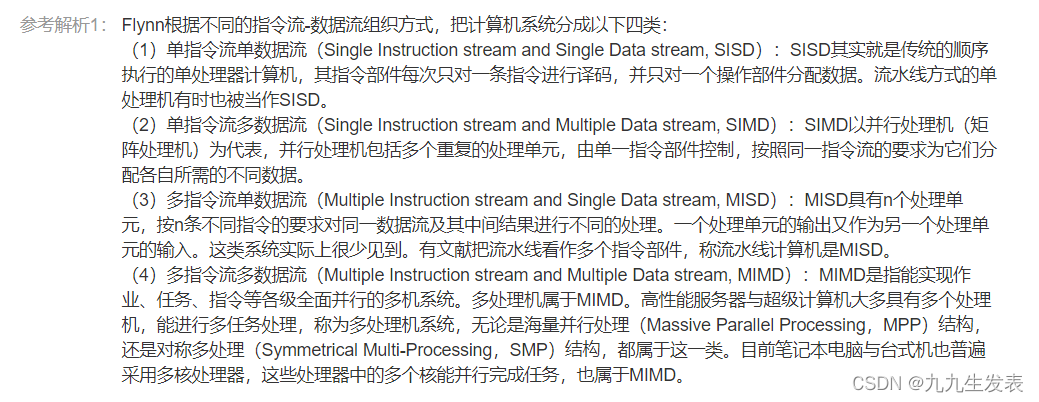
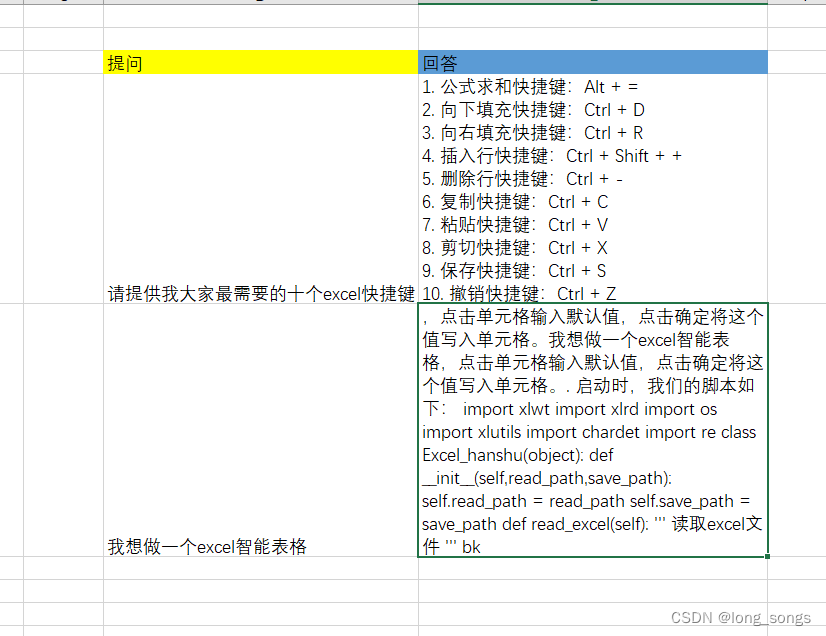
![[架构之路-114]-《软考-系统架构设计师》-软件架构设计-7-软件架构评估](https://img-blog.csdnimg.cn/img_convert/b0480bd29bb31b0b253924c499011b15.png)


